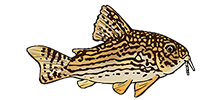I bought a baby syno. decorus the other day, and borought it home out of its double layered catfish bag and found that the stupid thing had a few white specs on it... white spot. Called them up, threw a bit of a fit on the phone (paying £13 / $25 for a fish that's sick) ...if it dies, I get a refund, fine. But it's in a tank with other baby synos, and tetras (dinner when they get bigger!) and I don't want them getting sick too. Basically they told me, don't fret, if they die, come in to the manager and he'll sort it out.
Anyway. I'm treating the tank with a half dose of King British WS3... for a week now. And his white spot is still the same. It's not bad, but not got better. Nobody else has shown signs of it. Is it safe to use the full dose on a scaleless fish - I know the bottle says not to, but I want to get rid of it!
Whitepot in Synodontis Decorus
-
Marc van Arc
- Expert
- Posts: 5038
- Joined: 19 Dec 2004, 14:38
- My articles: 20
- My images: 61
- My catfish: 9
- Spotted: 35
- Location 2: Eindhoven, The Netherlands
Re: Whitepot in Synodontis Decorus
To start with your last question: NO!! Don't use the full dose, unless you want to get rid of your fish as well.Princess wrote:I'm treating the tank with a half dose of King British WS3... for a week now. And his white spot is still the same. It's not bad, but not got better. Nobody else has shown signs of it. Is it safe to use the full dose on a scaleless fish - I know the bottle says not to, but I want to get rid of it!
Could you make a picture of the fish pls. That would clarify a lot, thus giving us the opportunity to give you advice based on facts instead of mere guessing.
I for instance doubt that it is white spot, but I have to see the patient first before making a diagnosis.
Moreover, it seems that the attitude of the LFS is fine, but imo it's far from good. It's like: let's wait and see how many fishes die and afterwards we'll sort it out. It should of course be the other way round, preferably without any casualties.....
- Richard B
- Posts: 6952
- Joined: 11 Aug 2006, 13:19
- I've donated: $20.00!
- My articles: 9
- My images: 11
- My cats species list: 37 (i:0, k:0)
- My aquaria list: 4 (i:0)
- My BLogs: 2 (i:0, p:29)
- Spotted: 10
- Location 1: on the sofa, or maybe at work?
- Location 2: Warwickshire: UK
- Interests: Tanganyika Catfish, African catfish, Non-loricariid sucker-catfish.
Running, drinking, eating, sci-fi, stapelids
Hi there
Hopefully this shouldn't be too much of a disaster for you. I have had good results using WS3 against whitespot. Have you made the temperature a little higher than normal? Around 80 degrees F is best for treating whitespot. It may take a while as the treatment is against the whitespot in it's free swimming stage - although i was talking to a manufacturer at a trade show last year about a product which treats the whitespot whilst on the fish (can't remember which one though (Doh!) I have used full doses on synos with no ill effects but you need to carefully work out the dosage allowing for displacement of rocks wood etc in the tank - if in doubt err on the side of caution.
I don't want to sound patronising but it always pays to spend as long as possible looking over that potential new purchase for external signs or something that seems out of character for the individual species & use an isolation tank if available for a while before adding to an existing system. I know i & many others have made these mistakes in the past when we just couldn't resist something.
Finally - are you sure it's whitespot. My (tang) synos often look like there is an outbreak of whitespot but it merely is a few grains of coral sand stuck to their body mucus - this obviously depends if you have a sand substrate or not
Best of luck & keep us posted
Richard B
Hopefully this shouldn't be too much of a disaster for you. I have had good results using WS3 against whitespot. Have you made the temperature a little higher than normal? Around 80 degrees F is best for treating whitespot. It may take a while as the treatment is against the whitespot in it's free swimming stage - although i was talking to a manufacturer at a trade show last year about a product which treats the whitespot whilst on the fish (can't remember which one though (Doh!) I have used full doses on synos with no ill effects but you need to carefully work out the dosage allowing for displacement of rocks wood etc in the tank - if in doubt err on the side of caution.
I don't want to sound patronising but it always pays to spend as long as possible looking over that potential new purchase for external signs or something that seems out of character for the individual species & use an isolation tank if available for a while before adding to an existing system. I know i & many others have made these mistakes in the past when we just couldn't resist something.
Finally - are you sure it's whitespot. My (tang) synos often look like there is an outbreak of whitespot but it merely is a few grains of coral sand stuck to their body mucus - this obviously depends if you have a sand substrate or not
Best of luck & keep us posted
Richard B




